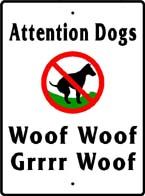 Dog Walkin’ Wellington
Dog Walkin’ Wellington
Dog Park Etiquette
By Barbara Phillippi
Taking your dog to an off-leash dog park, where he can roam free and socialize with other dogs, would seem to be very beneficial for both you and your pet – you satisfy your desire for your pet to exercise, and he develops socialization skills. But there are caveats and warnings that deserve discussion.
Animals must always be accompanied by their owners, and there are a few responsibilities when taking your dog to such an environment that you must consider. A dog park is not the place to visit with your dog as a substitute for walking it. To release mental frustration, one should first walk or exercise the dog before entering the park, otherwise excited mental energy could turn into a possible fight when your dog confronts the others.
It’s been my experience that too many people make the mistake of letting their animals run free, and completely disconnect the entire time their dogs are out playing and socializing. A dog whose owner turns it loose, then turns his back, is not under control. Sitting on a bench chatting, until it’s time to go home, means that you are potentially ignoring maintaining leadership of your dog, and inviting problems.
A responsible owner will make sure that his pet is in view at all times, and will be observing the body language of the animal, to ensure the pet’s safety and fun. The animal must always be under the owner’s control, and attention must be paid to dog “body language” with the other dogs that he encounters. High-set, slow-wagging tails, or not wagging at all, or ears pinned back, are signs warning that either dog is considering a possible conflict. Be quick to intervene, as it’s never a good idea to separate a dog fight, even for those with experience.
Don’t let your dog or other dogs mount each other, as this is sign of domination, and it’s important to ensure that the dogs in the park know that the owners are the dominant ones, and not the other way around. Mounting elevates excitement and can lead to a possible conflict.
It’s not a rule at all dog parks, but I believe that it should be; all dogs entering the dog park should be neutered. This is not the place to bring an intact male, or a female in heat. These animals cause intense excited energy, and a fight is almost a sure thing.
Make sure that running dogs are not actually chasing a dog that might be a weak, submissive animal. It’s natural in the wild for dogs to eliminate dogs in the pack that are weak, but that shouldn’t be happening in the dog park. Intervention by breaking the pack up, and sending each dog away from the weak dog, is immediately necessary. The weak dog should never be picked up; this only excites the rest, and they will start jumping at you to get at the victim.
Some dogs tend to ignore the social cues and greeting procedures of the other dogs. Ignoring dog greetings like sniffing, they leap in to play, putting paws on other pets, seemingly unaware that another dog is standoffish or dislikes this type of advance. These dogs also cause problems for fearful animals, who often resort to “fear biting,” especially if they’ve been victims of an aggressive dog in the past.
The sometimes controversial “Dog Whisperer” Caesar Milan has this suggestion – “Often, the best way for a dog to learn how to behave is from another dog. Reach out to a friend or neighbor with a well-socialized dog, and ask them to join you and your dog on walks. Preferably, this dog will also have a calmer energy than your own. Take your dogs on long walks together, and allow your dog to see the correct behavior from a well-socialized dog. If you don’t have a friend or someone to reach out to with a well-socialized dog, try reaching out to local trainers or rescue groups who may be able to help.”
Another big “no no.” Small children should never be included in a trip to the dog park. Many pets accept petting and touching from strange adults, but noisy, animated kids and an unbidden approach to an appealing puppy or dog are frightening to an animal that has not been raised or socialized with little human beings. This is when bites happen, and, following a seemingly innocent attempt to pet or play, a perfectly friendly dog can become aggressive with children for life.
Now a real biggie: Dogs can’t clean up after themselves outdoors. Unfortunately, most owners don’t either. Many dog parks provide waste bags, and receptacles for disposal. If you pretend that you don’t see your puppy squatting behind a bush a few yards away, believe me, someone else does, and you will be reminded that you need to get busy. Carry a bag at all times.
either. Many dog parks provide waste bags, and receptacles for disposal. If you pretend that you don’t see your puppy squatting behind a bush a few yards away, believe me, someone else does, and you will be reminded that you need to get busy. Carry a bag at all times.
A few interesting poop pick-up facts, who does, and who doesn’t?
“A survey of 1,000 people across the state by the N.C. Department of Environment and Natural Resources and East Carolina University Center for Survey Research, found that people aged 18 to 24 years and 65 years and older are most likely to report they always or often pick up pet waste. Two age groups tied for the least likely to pick up poop: 35-to 44-year-olds and 45-to 54-year-olds.
The pros and cons of public dog parks will be discussed, with

passion forever. Topics always include possible diseases and parasites that may or may not be lurking there, people who don’t pick up, if a pet is too large for a particular designated area, ad infinitum.
How will you and your dog fit into the pecking order, if you choose to go to a dog park? That can’t be predicted, but follow a few rules, enjoy, and remember that keeping your pet safe is always your job.
___________________________________________________________________________________
Dog parks in the western communities include –
the Wellington Dog Park,
The Royal Palm Beach Dog Park
http://www.doggoes.com/parks/florida/miami-fort-lauderdale/crestwood-dog-park
“Pooch Pines” in Okeeheele Park
http://www.bringfido.com/attraction/3275/
“In a perfect world, every dog would have a home, and every home would have a dog.”

